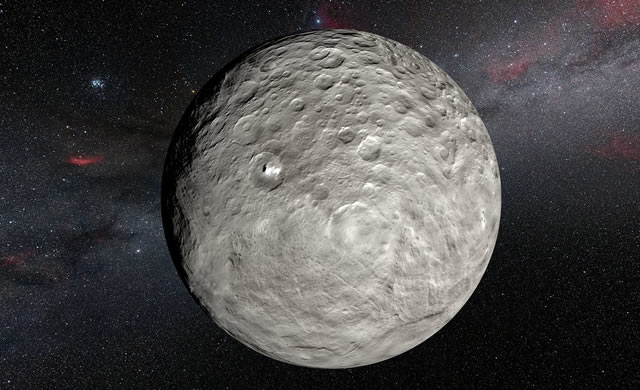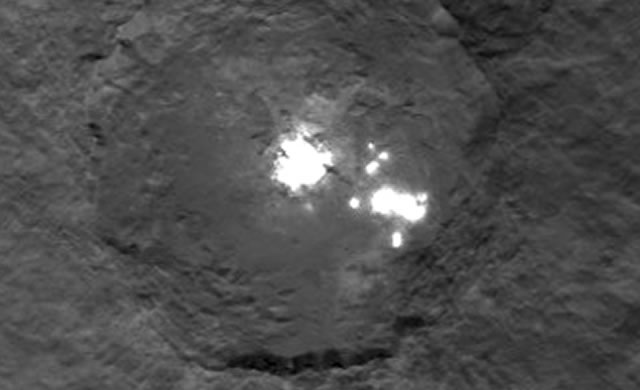
Credit:ESO/L.Calçada/NASA/JPL-Caltech/UCLA/MPS/DLR/IDA/Steve Albers/N. Risinger (skysurvey.org)
Osservazioni effettuate con lo spettrografo HARPS all’Osservatorio dell’ESO di La Silla in Cile hanno rivelato cambiamenti inaspettati nelle macchie chiare viste sul pianeta nano Cerere. Nonostante Cerere appaia come non più di un punto di luce se visto dalla Terra, studi approfonditi della sua luce mostrano non solo le variazioni attese a causa della rotazione di Cerere, ma anche altri cambiamenti nelle macchie, come una maggior luminosità durante il giorno. Queste osservazioni suggeriscono che la materia di cui sono composte sia volatile e evapori grazie al calore della luce solare.
Cerere è il più grande corpo celeste in orbita nella fascia degli asteroidi, tra Marte e Giove, e l’unico di essi classificato come pianeta nano. La sonda Dawn della NASA è in orbita intorno a Cerere da più di un anno e ne ha mappato la superficie in gran dettaglio. Una delle maggiori sorprese è stata la scoperta di macchie molto luminose, che riflettono molta più luce del resto della superficie circostante più scura.
La più evidente di queste macchie si trova all’interno del cratere Occator e suggerisce che Cerere sia un mondo più attivo degli asteroidi vicini. Nuove osservazioni molto precise con lo spettrografo HARPS installato sul telescopio da 3,6 metri dell’ESO a La Silla, in Cile, hanno non solo rivelato il moto delle macchie a causa della rotazione di Cerere intorno al proprio asse, ma hanno anche trovato variazioni inattese che suggeriscono che il materiale che forma le macchie sia volatile e evapori a causa dell’azione della luce del sole.
L’autore principale del nuovo studio, Paolo Molaro dell’INAF-Osservatorio Astronomico di Trieste, racconta: “Appena la sonda Dawn ha rivelato le misteriose macchie chiare sulla superficie di Cerere, ho immediatamente pensato a quali effetti fossero misurabili da Terra. Mentre Cerere ruota, le macchie si avvicinano a Terra e poi si allontanano e questo ha un effetto sullo spettro della luce del Sole, riflessa dalla superficie, che arriva fino a Terra.” Cerere ruota su se stessa ogni nove ore e i calcoli hanno mostrato che l’effetto dovuto al moto delle macchie in avvicinamento o allontanamento dalla Terra a causa della rotazione sarebbe stato molto piccolo, dell’ordine di 20 chilometri all’ora. Ma questo moto è abbastanza grande da essere misurabile tramite l’effetto Doppler con strumenti ad alta precisione come HARPS. L’equipe ha osservato Cerere con HARPS per poco più di due notti in luglio e agosto 2015.
“Il risultato è stata una sorpresa”, aggiunge Antonino Lanza, dell’INAF-Osservatorio Astrofisico di Catania e coautore dell’articolo. “Abbiamo trovato nello spettro le variazioni attese, dovute alla rotazione di Cerere, ma con differenze considerevoli tra una notte e l’altra.”
L’equipe ha concluso che i cambiamenti osservati potrebbero essere dovuti alla presenza di sostanze volatili che evaporano per effetto della radiazione solare. Quando le macchie all’interno del cratere Occator sono sul lato illuminato dal Sole, si forma una foschia che riflette la luce del Sole in modo molto efficiente. La foschia evapora rapidamente, perde riflettività e produce i cambiamenti osservati. L’effetto cambia da notte a notte, producendo gli effetti casuali aggiuntivi osservati su tempi scala sia brevi che lunghi. Se questa interpretazione venisse confermata, Cerere sarebbe molto diversa da Vesta e dagli altri asteroidi della fascia principale.
Pur essendo relativamente isolato, potrebbe possedere un’attività interna. Si sa che Cerere contiene al suo interno molte riserve d’acqua, ma non è chiaro se questa sia legata alle macchie luminose. La fonte di questa continua perdita di materia dalla superficie non è ancora nota.
Dawn continua a studiare Cerere e il comportamento delle sue strane macchie. Le osservazioni da terra con HARPS e altri strumenti potranno continuare anche dopo il termine della missione spaziale.
Fonte/Leggi tutto → ESO.org
Observations made using the HARPS spectrograph at ESO’s La Silla Observatory in Chile have revealed unexpected changes in the bright spots on the dwarf planet Ceres. Although Ceres appears as little more than a point of light from the Earth, very careful study of its light shows not only the changes expected as Ceres rotates, but also that the spots brighten during the day and also show other variations. These observations suggest that the material of the spots is volatile and evaporates in the warm glow of sunlight.

Ceres is the largest body in the asteroid belt between Mars and Jupiter and the only such object classed as a dwarf planet. NASA’s Dawn spacecraft has been in orbit around Ceres for more than a year and has mapped its surface in great detail. One of the biggest surprises has been the discovery of very bright spots, which reflect far more light than their much darker surroundings.
The most prominent of these spots lie inside the crater Occator and suggest that Ceres may be a much more active world than most of its asteroid neighbours. New and very precise observations using the HARPS spectrograph at the ESO 3.6-metre telescope at La Silla, Chile, have now not only detected the motion of the spots due to the rotation of Ceres about its axis, but also found unexpected additional variations suggesting that the material of the spots is volatile and evaporates in sunlight. The lead author of the new study, Paolo Molaro, at the INAF–Trieste Astronomical Observatory, takes up the story: “As soon as the Dawn spacecraft revealed the mysterious bright spots on the surface of Ceres, I immediately thought of the possible measurable effects from Earth. As Ceres rotates the spots approach the Earth and then recede again, which affects the spectrum of the reflected sunlight arriving at Earth.” Ceres spins every nine hours and calculations showed that the effects due to the motion of the spots towards and away from the Earth caused by this rotation would be very small, of order 20 kilometres per hour. But this motion is big enough to be measurable via the Doppler effect with high-precision instruments such as HARPS.
The team observed Ceres with HARPS for a little over two nights in July and August 2015. “The result was a surprise,” adds Antonino Lanza, at the INAF–Catania Astrophysical Observatory and co-author of the study. “We did find the expected changes to the spectrum from the rotation of Ceres, but with considerable other variations from night to night.” The team concluded that the observed changes could be due to the presence of volatile substances that evaporate under the action of solar radiation.
When the spots inside the Occator crater are on the side illuminated by the Sun they form plumes that reflect sunlight very effectively. These plumes then evaporate quickly, lose reflectivity and produce the observed changes. This effect, however, changes from night to night, giving rise to additional random patterns, on both short and longer timescales. If this interpretation is confirmed Ceres would seem to be very different from Vesta and the other main belt asteroids. Despite being relatively isolated, it seems to be internally active [3]. Ceres is known to be rich in water, but it is unclear whether this is related to the bright spots. The energy source that drives this continual leakage of material from the surface is also unknown. Dawn is continuing to study Ceres and the behaviour of its mysterious spots. Observations from the ground with HARPS and other facilities will be able to continue even after the end of the space mission.
Source/Continue reading → ESO.org






















Pingback: C’è acqua su Cerere – Foto Macchie Brillanti e Nuovi Dettagli – Bright Spots and Color Differences Revealed on Ceres | DENEB Official ©